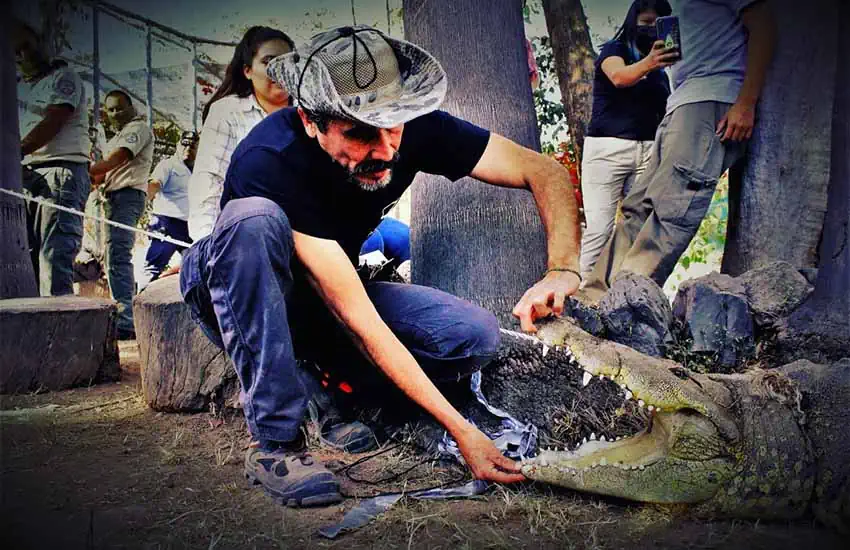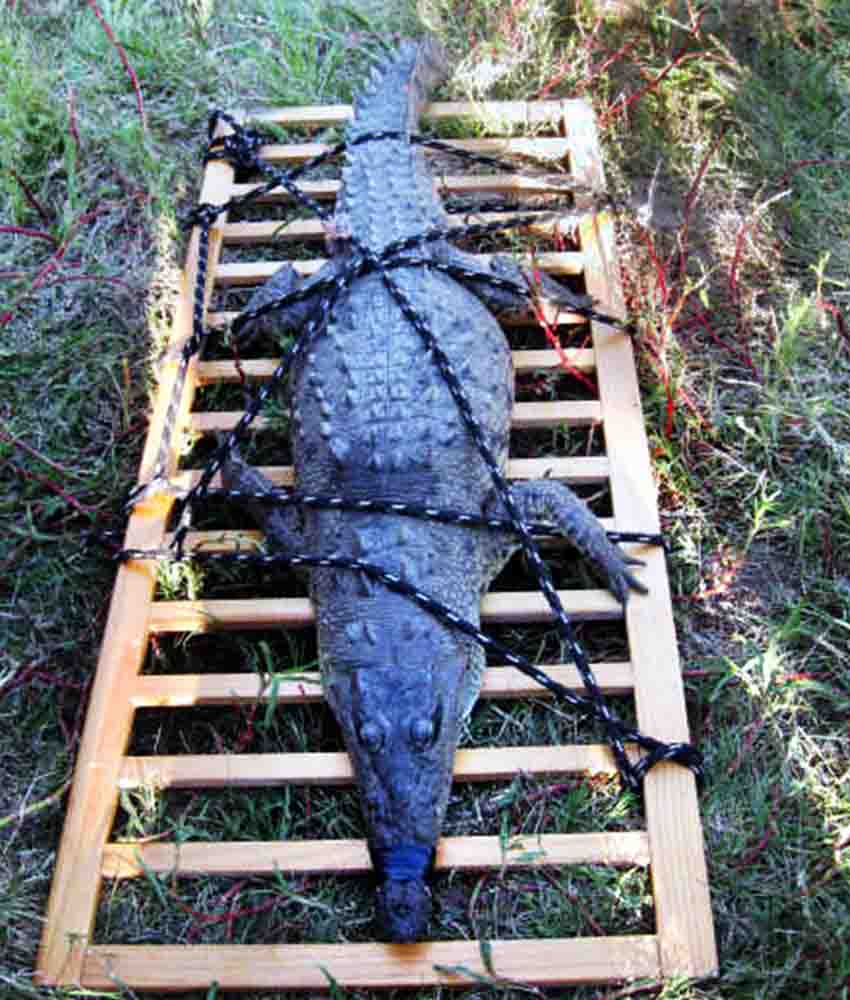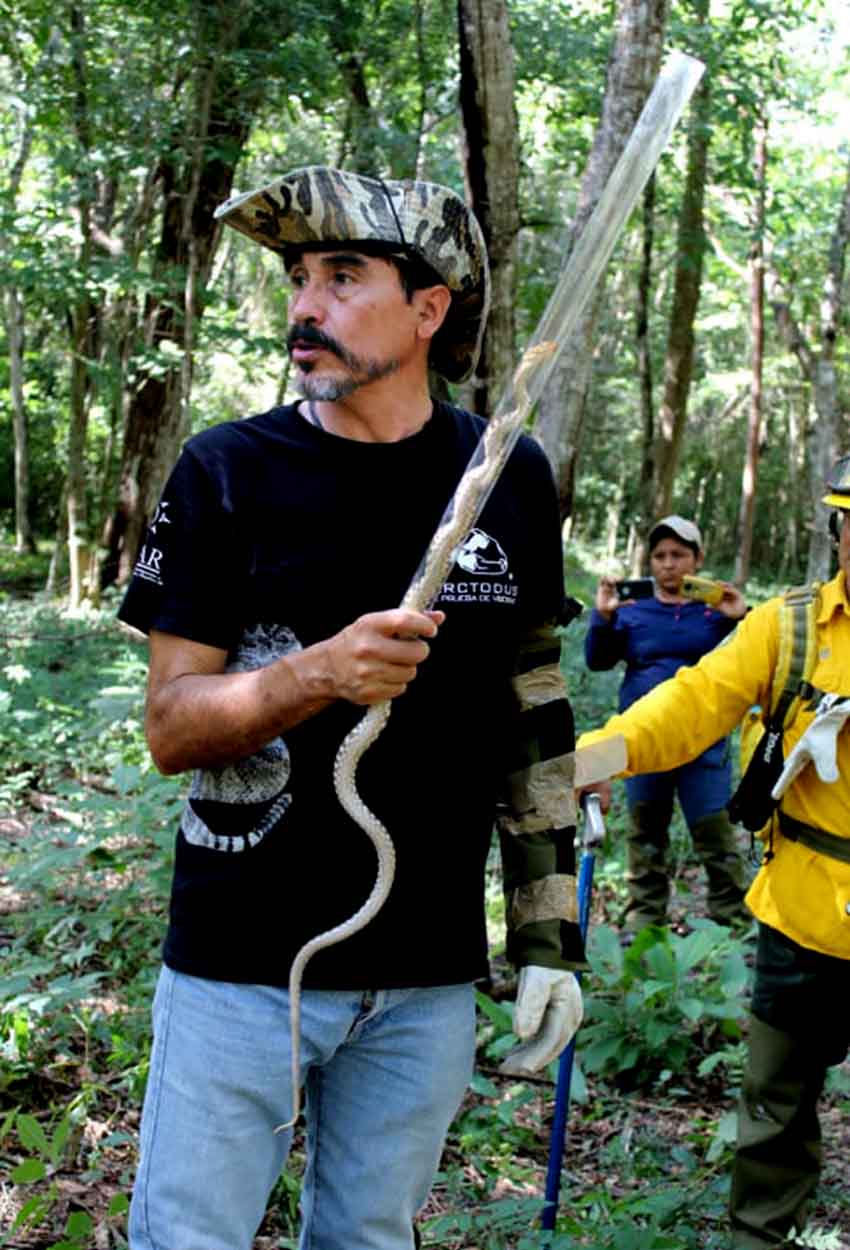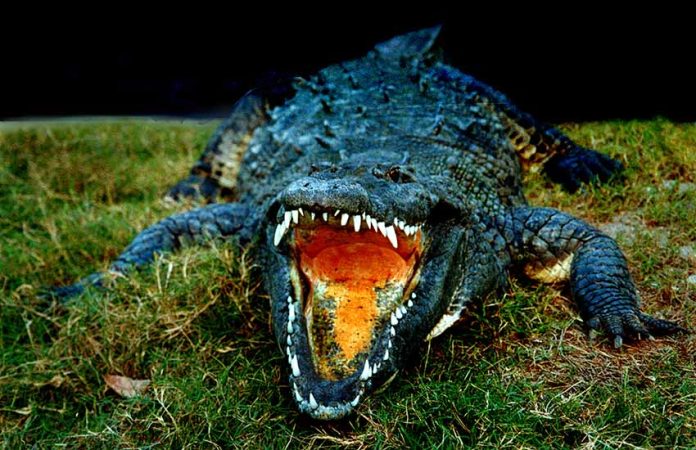In case anyone might have a doubt, Mexico does have crocodiles.
There are three species, in fact, but the most common is Crocodylus acutus, the American crocodile, which frequently lives in estuaries and can grow to a length of over five meters.
Biologist Paulino Ponce is an independent researcher specializing in crocodiles and human-croc conflicts. A graduate of the University of Guadalajara, he currently heads up a task force dedicated to the tricky business of finding and relocating misplaced crocodiles in Mexico’s biggest inland body of water, Lake Chapala.
“How did you get interested in crocodiles?” I asked Ponce.
“Bueno, I’ve always been fascinated by reptiles,” he replied. “When I was five years old, my father took us to a turtle sanctuary, and from then on, I was hooked! I loved reptiles of all kinds, but — you may not believe it — when I grew up, I started out studying music at Guadalajara’s Instituto Cabañas. Yes, I love music, sports and reptiles!”

Eventually, it seems the reptiles won out, and Ponce ended up at the Herpetarium of the Guadalajara Zoo.
“Here I worked with some of the most poisonous snakes in the world,” he said. “I really enjoyed this, but eventually it came time to do my thesis, and I wanted to write something really useful that would benefit whatever species I was studying — and also benefit the environment. So I picked Crocodylus acutus, which at that time was red-listed as being endangered.”
This led Ponce to the Los Tuxtlas Tropical Biological Station in Los Tuxtlas, Veracruz.
“Here,” he said, “I took a crocodilian training course with herpetologist Dr. [Gustavo] Casas Andreu of the National Autonomous University of Mexico. At night, people would say, ‘Come on, Paulino, let’s go have a beer!’ but I was so fascinated by what I was learning that all I wanted to do was read more about crocodiles!
“Then we went out to do fieldwork at a farm in Laguna Catemaco, also in Veracruz, and one of the course professors was Gonzalo Pérez-Higareda, a real expert in crocodiles. So there he was, demonstrating the problems and techniques for capturing a croc, and when he finished, he held up a rope and he says, ‘Okay, who wants to go out and catch one right now?’
“Well, I jumped right up and grabbed the rope and said, ‘Me! Me!’ And then there was this total silence in the room. Nobody else said a thing. It was a course all about crocodiles, but nobody else volunteered!”

I asked Ponce about the problem of crocodile attacks in Mexico.
“In 1993, the Mexican government organized a meeting about crocodile attacks that were taking place in Puerto Vallarta, where a child had supposedly died,” Ponce explained.
“After that,” he said, “there were meetings and meetings and meetings about crocodile problems, and over and over I would get up and say, ‘What in the world are we doing? While we’re sitting around here, a crocodile could be eating someone! Let’s go take care of the problem!'”
From that time on, Ponce began to take a personal hand in dealing with Jalisco’s crocodile situation.
One example took place in 1996, when a crocodile three meters long attacked a six-year-old girl in Puerto Vallarta. In this case, two crocs were captured and released elsewhere. In another case, a 4.68-meter croc killed a five-year-old boy in the estuary of the Tomatlán River in Jalisco. The culprit was captured and sent to an enclosure. And then there is the story of the crocodile discovered in 2009 in Bosque la Primavera, the huge forest located just west of Guadalajara. Crocs, of course, are not endemic to this forest, but there it was, swimming around in a pond known as El Carrizo.

On April 28, 2009, Ponce led a team of volunteer crocodile wranglers there for nighttime crocodile hunting.
At first, they simply watched the crocodile, observing its movements and favorite haunts. The reptile appeared nearly two meters long and had probably been feeding on turtles and tilapia for some time.
United States Peace Corps volunteer Marc Trinks was a member of the team, and he describes the first night they floated into the middle of the pond to confront the crocodile:
“We had a long pole with a noose at the end. Paulino was in the front of the boat, and I was in the back, navigating. We tried to approach the croc fast, kill the motor and coast up to him so Paulino could get him around the neck with the noose. We tried that three times that night until he got scared and wouldn’t let us get close to him anymore.
“And then, the second night, we tried the same thing a few times, and the croc went back in the creek where the pond starts. We corralled him there. We used nets to try to catch him. He got tangled up in one of them, but when we moved in close to grab him, he swam under the nets and escaped. So that was night two lost.”
The crocodile hunters, however, were not discouraged. The following morning, they were back in the pond, laying out snare traps baited with pieces of fresh fish.

Crocodiles trip these snares when they eat the bait and pull on it, causing the snare to close around the animal’s neck or body.
“On day three, at 2:40 in the afternoon,” Trinks said, “the croc fell into the trap and we got him.”
The crocodile turned out to be 1.74 meters long and “in good shape but a bit thin, possibly due to a scarcity of food in the area,” Trinks said.
Team member Karina Aguilar lamented the fact that the croc had apparently been placed there deliberately by “someone ignorant of how much damage such an action could cause not only to the animal but also to the equilibrium of the local ecosystem.”
Ponce took a sample of the crocodile’s DNA for his biogenetic database, and the Primavera croc was eventually returned to its natural habitat on the Pacific coast.
In Lake Chapala, much like in Bosque la Primavera, it was believed that there were no crocs, but that turned out not to be true.

“For years, I kept hearing rumors that people had seen crocodiles in the lake,” Ponce told me. Then, in 2011, they invited animal rescuer Andrés González and me to the town of Tizapán on the south shore of Lake Chapala to get a crocodile that local police had captured.
“To my surprise, I saw that it was a Crocodylus moreletii [Morelet’s crocodile] — a native of the Gulf of Mexico, mind you! To make matters worse, the Tizapán police said there was another one in an arroyo [stream] that they had been unable to capture.”
Why, I asked Ponce, are there crocodiles in Lake Chapala?
“Unfortunately,” he replied, “it was human beings who brought them here. After a lot of digging, I learned that years ago, a number of crocs escaped from a house in Michoacán, all of whom headed straight for the Lerma River [which connects Michoacán and Jalisco and eventually empties into Lake Chapala]. And this, it seems, is how the crocodiles made their way to Lake Chapala.”
Since the 1990s right up to the present, said the biologist, there have been many records of croc sightings around Lake Chapala, enough to merit ongoing patrolling.
Ponce has organized a team to do just this, “but,” he said, “we need to keep replacing our equipment, which wears out or gets damaged. For example, we need snares, lights, gasoline, nets, rope, camera traps, a GoPro [a small portable camera]. Our boat is for estuaries, but now we need a bigger one for moving around on the lake.”

Funding is the team’s biggest problem, and Ponce is looking for support from lakeside organizations.
“We need to monitor the whole lake,” he said. “Crocs keep turning up everywhere. We have registers from sites all around the lake, from Ajijic, Jocotepec, San Pedro, Jamay … and some of them measure more than three meters!” Lake Chapala is about 80 kilometers long and 20 kilometers wide.
“There are all kinds of places where aquatic plants abound and crocodiles can hide,” Ponce said. “Although there are few chances to be caught by a croc, I recommend caution. People should especially be watchful of their children and their pets. All of them are ‘bite size’ as far as crocodiles are concerned. We know that a crocodile can surprise and catch a fast animal like a cheetah, so one must be alert along the lakeshore. Sometimes a crocodile does grab an adult, a drunk, for example.”
“Once upon a time, more than 70% of the people bitten by crocs in Mexico were fishermen,” he said. “But these days, tourists are gaining on [them], not only at the lake but also in Cancún, Vallarta and Manzanillo.”
To report a croc sighting on Lake Chapala (in English or Spanish), call Paulino Ponce at his WhatsApp phone number: 331-574-9417. You can also send a message to [email protected]. Note the location and time of your sighting and the approximate size of the crocodile, and take photos or videos if possible.
And, if you have the financial means, consider lending the team a hand.
The writer has lived near Guadalajara, Jalisco, since 1985. His most recent book is Outdoors in Western Mexico, Volume Three. More of his writing can be found on his blog.
